The Thorne/Simplex/Unitype Type-Setting Machine is now largely forgotten, even in otherwise thorough histories of type. So completely did the hot metal composing technologies of the Linotype and the Monotype dominate the 20th century that the transition from hand to machine composition is now usually seen as an instantaneous event dated to the introduction of the Linotype in 1886 (or 1890). The only typesetting machine now remembered to any degree is the Paige, and that only because Mark Twain famously lost money on it.
Yet the Thorne (later called the Simplex, and later still the Unitype) deserves to be remembered. It worked. It was commercially successful. It was manufactured in quantity (1,500 to 2,000 machines). Its makers survived for over three decades (Thorne patented it in 1880, and the successor company appeared in business directories until at least 1918; see also [Hattersley]). Perhaps most importantly, it represents the logical path that one might have thought that machine composition would take in the 1880s.
Imagine that it is the mid 1880s and you are responsible for a printing establishment. For more than 400 years, metal type has dominated printing (with some competition from lithography in recent years). Metal type is the basis of your shop and your life. At the same time, type has always been an expensive, precious commodity. Composition - typesetting - by hand is even more expensive. Making type more cheaply is something you can't do - that's the typefounders' business. But setting type more cheaply is something that you'd very much like to be able to do in your own shop.
In such an environment, the obvious thing you need is a machine to set type. The Thorne was just such a machine. It let you set type from a keyboard. It assisted in the justification of lines, Perhaps most importantly, it automated the tedious distribution of type for re-use after printing. It was compact, probably quiet (I suspect that no one in living memory has heard one operate), and would have fit well into any composing room. It even had sophisticated keyboard features for entering entire words simultaneously which have not been matched even by computers today. As the Unitype selling agents Wood & Nathan Co. said in 1910, it "does not compel the printer to take up methods which are foreign to his training, but with cheap type and type of foundry excellence it adds its power of speedy composition without disorganizing the methods of the composing room." [Unitype WN 2].
By way of contrast, the Linotype must have been a very hard sell at first. It was loud and hot and potentially dangerous. It required the support of a machinist. It didn't use type at all, but cast strange slug-lines of type - and then melted them down again. (Even today it's difficult to imagine a letterpress printer willingly melting down perfectly good type.) By the 20th century, the Linotype had become the comfortable old friend of the printer, running along more or less reliably in the back room. But in the 1880s, common sense was on the side of the Thorne.
I am indebted to Stephen O. Saxe, whose digital reprints of Thorne, Simplex, and Unitype literature (see below) have given the general reader the first good look at the Thorne in a century.
Huss was unable to discover any biographical information about Thorne [Huss 1973]. With the advantage of online searching, however, some further evidence emerges.
Appleton's Annual Cyclopædia and Register of Important Events of the Year 1897 , Third Series, Vol. 2 (Whole Series, Vol. 37) (NY: D. Appleton and Company, 1898) contains an obituary notice for Joseph Thorne. It reads:
"Thorne, Joseph, inventor, born in Marlboro, Ulster County, N.Y., Feb. 17, 1826; died in Sing Sing, N.Y., May 4, 1897. [Sing Sing & Ossining]. He was of Quaker parentage, served through the Mexican War, and became an engineer. From his early youth he was fond of machinery, and for a time he was associated with Elias Howe while he was perfecting his sewing machine. Aferward he was connected with the Singer Company, and established and operated a factory in Scotland. Among his many inventions were a typewriter, a sewing machine, and the typesetting and distributing machine bearing his name." (623)
(It is a pleasant coincidence that Marlboro was where Goudy located his Village Press and Letter Foundery some 98 years after Thorne was born there.)
A brief obituary notice for Joseph Thorne appeared in Engineering News, Supplement, for May 6, 1897. It reads:
"Mr. Joseph Thorne, inventor of the Thorne typesetting and distributing machine, died at Sing Sing, N.Y., May 4, at the age of 71. He was at one time associated with Mr. Howe, the inventor of the Howe sewing machine, and later with the Singer Sewing Machine Co." (163)
This puts his date of birth at around 1826.
The Typographical Journal, Vol. 10, No. 10 (May 15, 1897) ("Craft Chat" column) gives his age at 72:
"Joseph Thorne, the inventor of the Thorne typesetting and distributing machine, is dead. Mr. Thorne was seventy-two years of age. He was an inventor from boyhood, and was for a long time associated with Howe, the inventor of the sewing machine. Later was with the Singer Company, and went to Scotland where he established a factory." (383)
A search of earlier patents for information about Joseph Thorne turns up some information. There was an 1859 patent, No. 26,536, for an improvement in sewing machines which was issued to a Joseph Thorne of New York City. Given his associate with Howe and Singer, it seems likely that this is the same Thorne. He would have been about 33 years old at this time.
There is also an 1888/1889 patent issued to a Joseph Thorne of Port Richmond, NY for a rotary engine. This is after Nelson acquired his company, and given the association with Port Richmond, I would think it likely that this is the same Joseph Thorne (who would have been about 62 in 1888).
In 1880, the year in which he was granted the initial patent for his typesetting machine, he would have been about 54 years old.
It is also interesting to observe that Thorne seems associated with Port Richmond, NY in both 1880 and 1888, while the manufacture of the machine is associated with Hartford, CT. The reason is probably the presence of a precision manufacturing capability in Connecticut with the Colt establishment.
The most reliable modern study of this line of type-setting machinery seems to be that in Richard Huss' 1973 book The Development of Printers' Mechanical Typesetting Methods: 1822-1925 [Huss 1973]. (In turn, much of Huss' data probably comes from John Thompson's 1904 History of Composing Machinery [Thompson 1904].)
Huss relates the underlying principles of operation of the Thorne machine to the 1849 "Tachéotype" of Christian Sörenson in Denmark (Huss' Catalog No. 13). He notes, however, that it is unlikely that Joseph Thorne was aware of this earlier work. Huss traces the principle of using nicked type and wards for distributing type to the first proposed type distributer, that of the the 1840 "Gérotype" of Etienne Robert Gaubert (Huss' Catalog No. 5).
However, an anonymous article in a 1994 issue of the newsletter of the International Printing Museum claims that "The earliest documented evidence related to its invention is in 1869 when Thorne commissioned the R. Hoe Printing Manufacturing Company to manufacture a prototype of his experimental machine, based on the ideas of Christian Sorenson of Sweden." [IPM 1994].) The article does not cite any source for this information, and I have not yet confirmed it in any other source. [Thompson 1904] says only that Joseph Thorne "had since 1869 been experimenting with typesetting machines of the usual [meaning non-cylindrical] pattern" (27).
The first firm evidence of this machine is a US patent, No. 232,157, issued Sept. 14, 1880 to Joseph Thorne (then of Port Richmond, NY). The Thorne is Catalog No. 85 in [Huss 1973]. As shown in the 1880 patent, it is clearly the same basic machine as the Thorne as produced commercially, but it differs in certain respects. Here it is as shown in the 1880 patent:
I am aware of no trade references or surviving literature to the Thorne as it was first manufactured by Joseph Thorne, before Nelson's involvement. It is interesting to observe that the 1887 Scientific American article on the Thorne shows one machine in its main illustration but describes a different machine in its diagrams. This other machine looks much more like that of Thorne's original 1880 patent.
The exact corporate history of the Thorne company and its successors is not yet entirely clear. However, [Thorne 1894] identifies R. W. Nelson as the president of the company. Robert W. Nelson became a director of the American Type Founders Company in 1894, and assumed control of ATF soon after. He is best remembered for his role as head of ATF, but in the 1880s and early 1890s he was better known for having been a co-founder of the very successful American Press Association in 1882. This was a forerunner of the modern press syndicate which distributed stories to subscribing newspapers in the form of ready-to-use stereotype printing plates. (See the CircuitousRoot Notebook on Robert W. Nelson for more information on him.)
The 1891 Illustrated Popular Biography of Connecticut has this to say about Nelson's involvement with the Thorne company:
"Five years ago [thus ca. 1886], while still connected with the American Press Association, Mr. Nelson became interested in the ingenious Thorne Type-Setting Machine, then manufactured in a small way in Hartford by its inventor and patentee, Joseph Thorne. He acquired first a one-half interest in the enterprise, and a year or two later bought out Mr. Thorne altogether, and proceeded, with the aid of expert assistants to improve and at length to perfect the machine. Having accomplished this, he organized the Thorne Type-Setting Machine Company, with a capital of one million dollars, established a factory in the west wing of Colt's Amory, in Hartford, filled it with special machinery, and is now employing about seventy-five skilled mechanics in the manufacture of type-setting and distributing machines, the product of the plant being about twenty of these machines per month. The Thorne is the only type-setting machine now in use to any considerable extent. It revolutionizes the art of composition, as the introduction of power presses revolutionized the art of printing. Mr. Nelson is president of the company, and its general manager; as such, he has introduced the "Thorne" into all parts of the United States, Canada, England, Ireland, Scotland and Australia." [Spalding 1891], pp. 220-221
Although his background was not in engineering, Nelson was issued three patents relating to the Thorne ( No. 402,537 (1889), No. 417,074 (1889) and No. 528,106 (1894)).
Nelson's influence on the Thorne also can be seen in the typefaces shown as standard in the 1894 booklet. Several of these were chosen to match identically the faces used by Nelson's American Press Association, allowing newspapers to set matter to match stories supplied by the APA on stereotype plates.
As noted earlier, I am aware of no surviving illustrations or descriptions of the Thorne as it was manufactured by Joseph Thorne himself, before Nelson's participation. The earliest accounts of the machine in the press and in the surviving examples of company's own literature date from the period 1887 [SciAm 1887] to 1894 [Thorne 1894]. [Huss 1973] dates the machine by its patent (1880) but illustrates it from its 1887 description in Scientific American.
Here is the Thorne machine as it appeared by 1887, soon after the start of Nelson's involvement.
(From the 1887 Scientific American article on the Thorne [SciAm 1887].)
Note, however, that if you look closely at the machine shown in the cut above its keyboard differs from the keyboard shown in [Thorne 1894]. It is a more or less straightforward alphabetic arrangement (with some interesting exceptions, such as the placement of 'e'). There is of course no way now of knowing if this was an accurate depiction of the 1887 Thorne keyboard. Here is a closer look at this keyboard:
The Thorne would automatically load type into the machine (or distribute used type into the machine) and set it into unjustified lines under keyboard control. It did not automatically justify lines; that was done by hand by a second operator (or, by at least 1894, a lone operator, having swung himself or herself over to the justifier's position on the pivoted operator's chair) [Thorne 1894].
The keyboard of this machine as it was described in [Thorne 1894] would deserve special note even today. Each key was assigned an underlying number. If two or more keys were pressed simultaneously, types for each would be set in the order of the keys' underlying numbers. This allowed certain short words or syllables to be set by pressing all of their keys simultaneously (reducing the time taken to set such a word or syllable to the same duration as the time taken to key a single character). Here's a view of the keyboard from that brochure:
I believe that each Thorne machine was specific to a single body size of type, and that it could be loaded with the type of a single face only. The Thorne literature does not empahsize this. (This was confirmed for the Simplex in [Thompson 1904], p. 30.)
The most visible external feature of the 1887 Thorne as shown here is the lack of a pivoted chair allowing a single operator to swing between composing (keyboard) and justifying stations. However, this pivoted chair is shown on Thorne machines as shown in [Thorne 1894] and in ATF catalogs from 1895 on. It was present on all Simplex and Unitype machines.
[Huss 1973] dates the reorganization of the Thorne company into the Unitype Company to 1897, and says that their first product was the Thorne re-branded as the "Simplex One-Man Typesetter."
[Thompson 1904] says "In 1898 the company was succeeded by the Unitype Company and the entire machine remodeled and brought out as the Simplex One-Man Typesetter." (30)
They were certainly operating as the Unitype company by at least 1899. The Special Acts and Resolutions of the State of Connecticut, Vol. 13 (1899 and 1901) records that on April 11, 1899 the House of Representatives of the State of Connecticut approved "House Joint Resolution No. 134":
"Resolved by this Assembly: That The Unitype Company now located and having a place of business in the town of Manchester be and the same [sic] is hereby exempted from all town, highway, and school district taxation in said town for five years from October first, 1898."
At least one source indicates that in 1898 the Thorne and Cox companies merged to form the Unitype Company, and that this resulting company intended to market both a new Thorne machine and the Cox machine. [BP 1898]. Thompson says that "An attempt was made to embody the Cox method of justification in the Simplex machine, but without success" [Thompson 1904], p. 42.
We know that in 1901 the updated Thorne machine was being sold as the "Simplex" because of a sales brochure using that name which is datable on internal evidence to 1901. [Simplex 1901]. Here it is as shown on that brochure:
The "Simplex" is Huss' Catalog No. 183 [Huss 1973]. He attributes to it an automatic loading mechanism for dead type to be distributed. He also notes (without giving his source) that "by 1903 more than 1,500 Simplex (or Unitype) machines were in use throughout the country." (p. 196) This particular entry in Huss' book is illustrated with a photograph by him of notched type for the Simplex.
Illustrations of multiple sizes of this machine are rare. Here's an advertisement from a reconditioned machinery dealer from 1909 offering for sale (and identifying and illustrating) various sizes of the Simplex:
(From The Inland Printer, Vol. 44, No. 1 (October 1909): 37. Digitized by Google from the University of Minnesota copy.)
(By the January 1910 number, their ad indicated that the 8-point 13 em machine, No. 943, had been sold.)
The final iteration, the "Unitype," is Huss' Catalog No. 187 [Huss 1973] Huss dates it to 1898, but it would appear that this is simply a year in which its development was known to be underway. The Simplex (not the Unitype) was still being advertised by the Unitype Company at least as late as October 1906, and the 1909 Wood & Nathan Co. advertising campaign suggests that the Unitype was newly introduced at about that point (though their claims are characteristically hyperbolic).
Huss associates the engineer Paul F. Cox with the machine, and indicates that the Unitype company had also bought out the earlier patents of Cox. [Huss 1973] Cox introduced a method of automatic justification by the compression of corrugated metal spaces. (These would have avoided the Schuckers patent on the double-wedge spaceband which was causing the Mergenthaler company so much trouble at this time.)
Here it is as shown in an undated early 1900s brochure by Wood & Nathan (as sales representatives) [Unitype WN].
For more on Cox's earlier work, see Huss' Catalog No. 148 (Cox Type and Logotype Machine, 1894) and No. 149 (Cox Typesetter, Space Discarder, and Distributor). The latter used compressible spaces. Paul F. Cox was one of five brothers (Huss p. 166). His brother Walter H. Cox invented an "Automatic Logotype Distributor" (Huss, Catalog No. 157). [Huss 1973]
The transition to the Unitype began by 1899, although as can be seen in the Company Literature section, below the Simplex was still marketed under that name as late as 1901. In June of 1899, that year The Inland Printer carried a one page illustrated story on the Simplex ( reprinted below). In the "Machine Composition Notes and Queries" column for July of that year, however, they note:
"The Unitype machine, now under course of construction by the Unitype Company, gives promise to more than meet the expectations of its promoters. ... It is uncertain at present when the machine will be ready for the market..."
( Inland Printer Vol. 23, No. YYY (): 483-484)
Huss also says that in 1902 the Unitype company announced that the Des Jardins Justifier "would be part of the machine." [Huss 1973] Huss lists the Des Jardins Justifier of 1896 as his Catalog no. 162, but it isn't yet clear to me that this, specifically, would have been the machine referred to. An 1896 Inland Printer article on the Des Jardins machine indicates that it was developed initially in Chicago but that B. M. Des Jardins moved to Hartford, CT in 1892. [IP 1896 DJ]
But there was considerable development of type justifying apparatus within the Unitype company in the first decade of the century. In 1904, Watson was granted a patent for a type justifying machine which was assigned to Unitype, and in 1906 Johnson was granted two such patents. In 1907, Des Jardins, Ennisson, and Wentscher were all issued a series of patents on the same day, each assigned to the Unitype Company, for type justifying machinery. (See the Patents section, below, for reprints of these.)
Here is the 1896 Des Jardins Type Justifier:
(From [IP 1896 DJ]
As makers of one of the more successful type setting machines, the Unitype company seems to have absorbed several of the less commercially successful machines and their developers. In addition to Cox and Des Jardins, the patent record also indicates that Frank Amos Johnson [Tachytype] assigned several of his patents for later developments of his machines to the Unitype company.
The last patent I've been able to locate which was assigned to the Unitype Company is No. 1,150,134, filed 1913-07-10 and issued 1915-08-17 to Emil F. Linke. It is for an improvement in the assembler in a rotary machine such as the Thorne.
The Industrial Directory of New Jersey for 1918, "compiled and published by the Bureau of Industrial Statistics, Department of Labor" (Paterson, NJ: News Printing Company, 1918) lists the Unitype Co. as a manufacturer of "Typesetting machines" with approximately 20 employees. (p. 284)
An advertisement in Machinery, Vol. 24, No. 12 (August 1918), p. 62, for the Wood Turret [lathe] Machine Company mentions the Unitype Company of Jersey City, NJ as one of their customers. No doubt there is little coincidence that this was at the time the location of the central plant of ATF.
I have not yet been able to determine the ultimate fate of the Unitype company as a business entity. A brief note in The Typographical Journal, Vol. 51, No. 5 (1917-11) observes that "O. Judson Houck, a member of Typographical Union No. 6 and for a number of years with the unitype department of the American Type Founders Company, has joined the sales force of the Interytpe Corporation." (p. 440). This suggests that it quietly merged into ATF. However, I have not yet found any other confirmation of a direct acquisition of the Unitype Company by ATF in firsthand documents.
An anonymous article, "The Pioneer Days of 'Monotype' Composing Machines," which comprised the bulk of The Monotype Recorder (Vol. 39, No. 1 (Autumn, 1949), pp. 3-29) says:
"In the following year [1893] the American Type Founders Company (A.T.F." took over its biggest single customer, the Thorne Typesetting Machine Company, which was merged with the Cox Typesetting Machine (controlled by the Barnhart Bros. & Spindler type foundry) to form the Unitype company."
However, this is merely a suggestive secondhand report over a half-century after the fact, by a source with a vested interest in portraying type-setting machines as quaint. It contains some verifiable inaccuracies (Nelson was not associated with ATF until 1894 for example, not 1893) and cannot therefore be taken as reliable evidence.
Special thanks are due to Stephen O. Saxe for scanning and reprinting Thorne/Simplex/Unitype literature from his personal collection.

Thorne (1894)
"The Thorne Type-Setting Machine." (Hartford, CT: The Thorne Type-Setting Machine Co., 1894)
This document has been digitized by Stephen O. Saxe from a copy in his collection. The icon at left links to a presentation of this digitization at The Internet Archive. There it may be read online or downloaded in its original PDF or other formats.
Here is the same PDF file which is presented at The Internet Archive. ThorneTypeSettingMachine1894.pdf (This PDF is 66 Megabytes, generated at a mix of 75 and 85 percent JPEG "quality" level. A version generated at 100 percent would be 473 Megabytes in size, which is a bit too large to present here. If you need higher resolution imagery, see the Original Scan Data section, below.)
Here's the picture of the Thorne from this brochure as an image file (not PDF). Click through it for a medium-sized (2048 pixel wide) JPEG version (generally useful for most viewing).
This brochure also shows four views of the Thorne plant. It's a rather up-to-date plant for the time; one I'd be proud to put in my brochure. Note in particular the good lighting along both walls. There are also a number of special-purpose machine tools. For more on Thorne manufacturing, albeit at their later plant in Brooklyn, see the 1908 article in American Machinist, below .
Finally, here is the keyboard. This is not the same keyboard layout used in the 1887 Thorne or the one used later with the Unitype.
For higher-resolution versions of any of these images, see the Original Scan Data section, below.
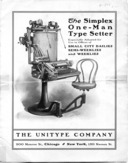
The Simplex One-Man Type Setter (1901)
"The Simplex One-Man Typesetter." (NY: The Unitype Company, 1901) [undated, but datable to 1901 through its references to the Pan-American Exposition]
This document has been digitized by Stephen O. Saxe from a copy in his collection. The icon at left links to a presentation of this digitization at The Internet Archive. There it may be read online or downloaded in its original PDF or other formats.
The version at The Internet Archive was processed to JPEG images within the PDF at a "quality" factor of 80 (for a 35 Megabyte file). Here is the same document converted at a JPEG quality factor of 100 (for a 57 Megabyte file): simplex-1901-desatlum.pdf For the original scans as lossless PNG images, see the Original Scan Data section, below.
Here's the picture of the Simplex from this brochure as an image file (not PDF). Click through it for a medium-sized (2048 pixel wide) JPEG version (generally useful for most viewing).
For the original scan as a lossless PNG image, see the Original Scan Data section, below.
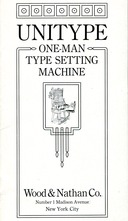
Unitype One-Man Type Setting Machine (1900s)
"The Unitype One-Man Type Setting Machine." (NY: Wood & Nathan Co.) This brochure is undated, but as it refers to the "Unitype" as an improvement over the "Simplex" it must postdate the "Simplex One-Man Type Setter" brochure of 1901 (see above) Wood & Nathan Co. were advertising the Unitype in The Inland Printer as late as 1910.
This document has been digitized by Stephen O. Saxe from a copy in his collection. The icon at left links to a presentation of this digitization at The Internet Archive. There it may be read online or downloaded in its original PDF or other formats.
Here is a local copy of the same PDF uploaded to The Internet Archive: UnitypeOneManTypeSettingMachineWoodNathan.pdf This PDF was generated at mixed JPEG quality factors (85 percent for the image pages, 75 percent for the text pages) for a 30 Megabyte file. Here is the same document converted at a JPEG quality factor of 100 Here is the same document converted at a JPEG quality factor of 100 (for a 129 Megabyte file): UnitypeOneManTypeSettingMachineWoodNathan100.pdf For the original scans as lossless PNG images, see the Original Scan Data section, below.
Here are the halftone images from the brochure as image files (not PDFs). Click through on each of them for a medium-sized (2048 pixel wide) JPEG version (generally useful for most viewing). It appears to be a slightly more substantial machine than the Simplex, and it abandons the characteristic Thorne/Simplex round base for a more conventional rectangular stand.
For the original scans of each of the images above as lossless PNG images, see the Original Scan Data section, below.
As an aficionado of keyboards, I cannot help adding the image of the layout of the Unitype keyboard, as well. To the best of my knowledge this keyboard layout has no name. It is not the same layout as that used on the Thorne in 1887 or on the Thorne by 1894.
While ATF amalgamated in 1892, many of its component typefoundries operated largely independently for some time after that. R. W. Nelson (president of the Thorne company) did not join ATF until 1894.
Advertisements for the Thorne do not appear in the 1893 Catalogue and Price List of Type and Material put out by the Cleveland branch of ATF , but one does appear in the 1895 ATF/Cleveland Catalogue and Book of Specimens of Type Faces and Printing Material and Machinery .
(Source: Catalogue and Book of Specimens of Type Faces and Printing Material and Machinery . (Cleveland, OH: American Type Founders' Company [Cleveland Type Foundry branch], 1895.) A digital version of this book, including the original page scans, is available at The Internet Archive. See: the entry for it in the CircuitousRoot ATF specimen page. Here is the original JPEG2000-format page scan: cataloguebookofs00clevrich_raw_0473.jp2 and, if you cannot handle JP2, my PNG conversion of it: cataloguebookofs00clevrich_raw_0473.png )
An ad also appears in the 1896 ATF Pacific Coast Blue Book:
(Source: Pacific Coast Blue Book - Containing Specimens of Type.. Printing Machinery [and] Printing Material... . (San Francisco, CA: American Type Founders' Company, 1896.) A digital version of this book, including the original page scans, is available at The Internet Archive. See the entry for it in the CircuitousRoot ATF specimen page. Here is the original JPEG2000-format page scan: pacificcoastblue00amerrich_raw_0133.jp2 and, if you cannot handle JP2, my PNG conversion of it: pacificcoastblue00amerrich_raw_0133.png )
An ad appears in an unidentified 1897 ATF catalog (there were several, by different branch foundries of the firm), seen here in a scan by Stephen O. Saxe:
The same ad appears in the Buffalo edition of the 1897 ATF Handy Specimen Book (but on page 571 (PDF 593), not on page 71). It also appears in the 1898 ATF Desk Book (p. 873; but with "Prices on application" rather than f.o.b. Hartford). It is still called the Thorne in both. Here it is from 1897 (Buffalo):
(Source: Handy Specimen Book[:] Specimens of Type[,] Borders & Ornaments[,] Brass Rule, Wood Type, etc. [and] Catalogue of Printing Machinery and Materials, Wood Goods, etc. . (Buffalo: American Type Founders Company, 1897.) A digital version of this book, including the original page scans, is available at The Internet Archive. See the entry for it in the CircuitousRoot ATF specimen page. Here is the original JPEG2000-format page scan: cu31924014559730.jp2 and, if you cannot handle JP2, my PNG conversion of it: cu31924014559730.png )
A slightly different ad appears on p. 829 (PDF 831) in another edition of the 1897 ATF Handy Specimen Book :
(Source: Handy Specimen Book[:] Specimens of Type[,] Borders & Ornaments[,] Brass Rule, Wood Type, etc. [and] Catalogue of Printing Machinery and Materials, Wood Goods, etc. . ([no location]: American Type Founders Company, 1897.) A digitization of the Brigham Young University copy of this book, including the original page scans, is available at The Internet Archive. See: the entry for it in the CircuitousRoot ATF specimen page. The image above links to a JPEG scaled cropping of a single page taken from that digitization. Here is the original JEG200-format page scan: specimensoftypeb00amer_orig_0831.jp2 and, if you cannot handle JP2, my PNG conversion of it: specimensoftypeb00amer_orig_0831.png)
The machine does not appear in the 1906 American Line Type Book .
1899-09-28:
[click image to view larger]
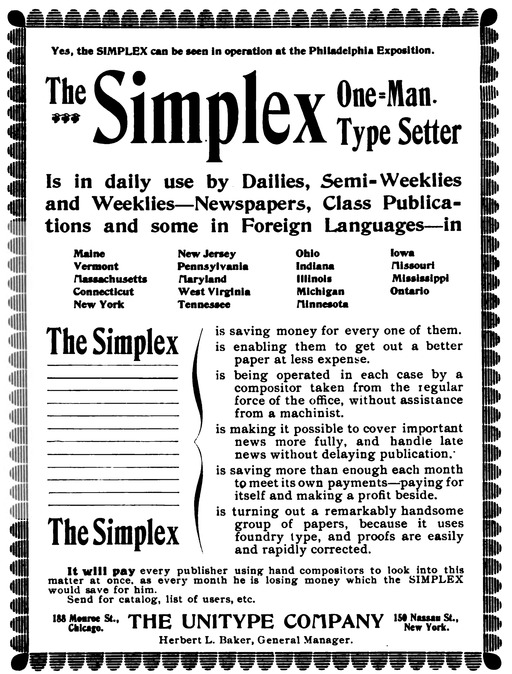
(From Newspaperdom, Vol. 8, Issue 7 (1899-09-28): 7. Digitized by Google. The image above links to a 600dpi rendering of just the ad. Here is a PDF extract of the entire page: newspaperdom-v08-issue07-1899-09-28-google-mich-p7-simplex.pdf )
1899-10-12: Newspaperdom Vol. 8, Issue 9 (1899-10-12): 6. The same advertisement as 1899-09-28.
1899-11-12:
[click image to view larger]

(From Newspaperdom, Vol. 8, Issue 11 (1899-11-16): p. 6. Digitized by Google. The image above links to a 600dpi rendering of just the ad. Here is a PDF extract of the entire page: newspaperdom-v08-1899-11-16-p6.pdf )
(From Newspaperdom, Vol. 8, Issue 13 (1899-11-30): p. 3. Digitized by Google. The image above links to a 600dpi rendering of just the ad. Here is a PDF extract of the entire page: newspaperdom-v08-issue13-1899-11-30-google-mich-p3-simplex.pdf )
(From Newspaperdom, Vol. 8, Issue 15 (1899-12-14): p. 3. Digitized by Google. The image above links to a 600dpi rendering of just the ad. Here is a PDF extract of the entire page: newspaperdom-v08-issue15-1899-12-14-google-mich-p3-simplex.pdf )
1899-12-28: Newspaperdom Vol. 8, Issue 17 (1899-12-28): 6. The same advertisement as 1899-12-14.
(From Newspaperdom, Vol. 8, Issue 21 (1900-01-25): p. 6. Digitized by Google. The image above links to a 600dpi rendering of just the ad. Here is a PDF extract of the entire page: newspaperdom-v08-issue21-1900-01-25-google-mich-p6-simplex.pdf )
1906:
[click image to view larger]
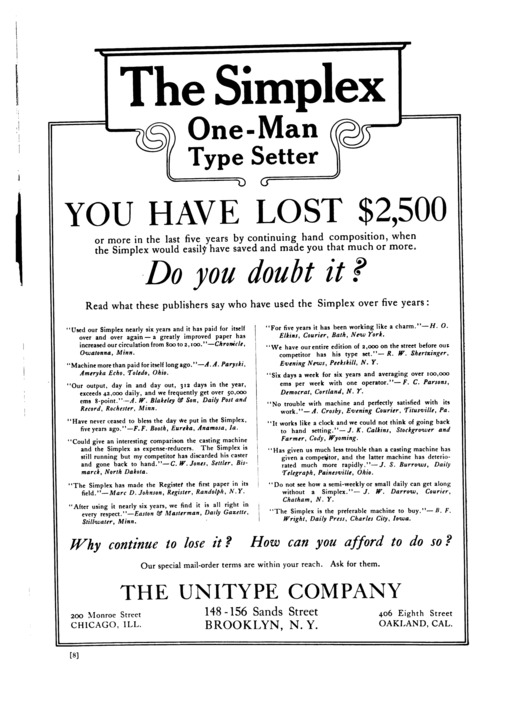
(From The Inland Printer, Vol. 38, No. 1 (October 1906): 8. Digitized by Google from the University of Michigan copy.)
In mid-1909, the NY firm of Wood, Nathan and Co. (who a few years earlier had been representing the Lanston Monotype Machine Company) began promoting and selling Unitypes. They appeared to market them aggressively as straight-matter machines in shops with mixed equipment for typesetting and composition casting. See also [Unitype WN 2].
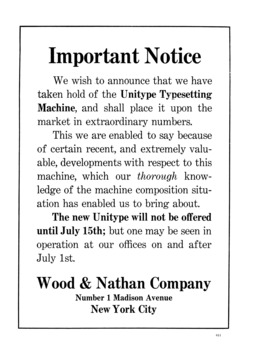
(From The Inland Printer, Vol. 43, No. 4 (July 1909): 697. Digitized by Google from the University of Minnesota copy.)
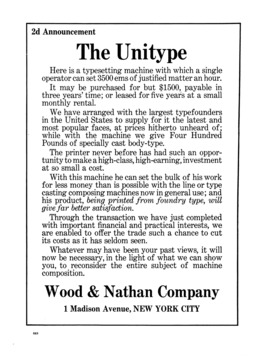
(From The Inland Printer, Vol. 43, No. 5 (August 1909): 648. Digitized by Google from the University of Minnesota copy.)
1909 (September): (No Wood & Nathan advertisement appeared in The Inland Printer in September 1909.)
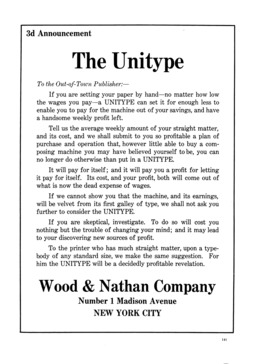
(From The Inland Printer, Vol. 44, No. 1 (October 1909): 141. Digitized by Google from the University of Minnesota copy.)
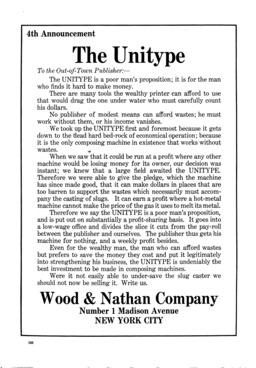
(From The Inland Printer, Vol. 44, No. 2 (November 1909): 188. Digitized by Google from the University of Minnesota copy.)
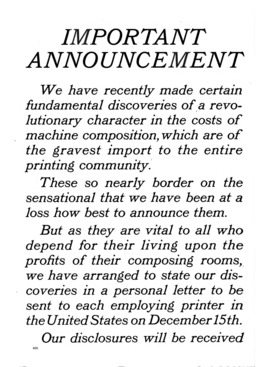
(From The Inland Printer, Vol. 44, No. 3 (December 1909): 468-469. Digitized by Google from the University of Minnesota copy.)

(From The Inland Printer, Vol. 44, No. 4 (January 1910): 619. Digitized by Google from the University of Minnesota copy.)
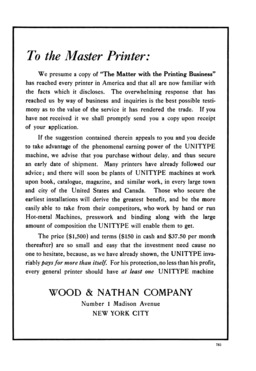
(From The Inland Printer, Vol. 44, No. 5 (February 1910): 783. Digitized by Google from the University of Minnesota copy.)
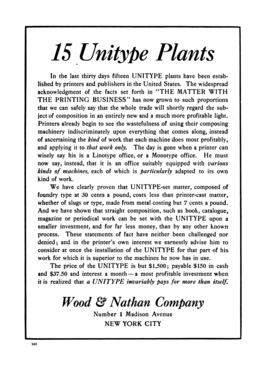
(From The Inland Printer, Vol. 44, No. 6 (March 1910): 946. Digitized by Google from the University of Minnesota copy.)
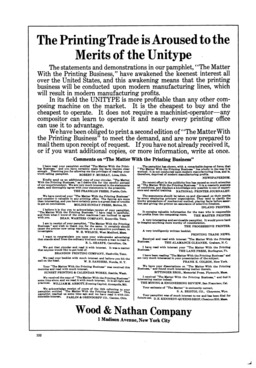
(From The Inland Printer, Vol. 45, No. 1 (April 1910): 152. Digitized by Google from the University of Michigan copy.)
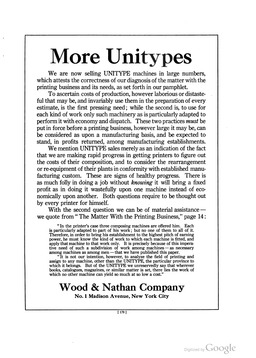
(From The Printing Art. Vol. 15, No. 2 (April 1910): 179. Digitized by Google from the University of Michigan copy.)
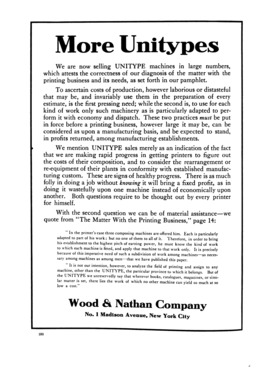
(From The Inland Printer, Vol. 45, No. 2 (May 1910): 188. Digitized by Google from the University of Michigan copy.)
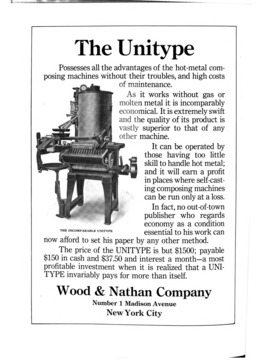
(From The Inland Printer, Vol. 45, No. 3 (June 1910): 364. Digitized by Google from the University of Michigan copy.)
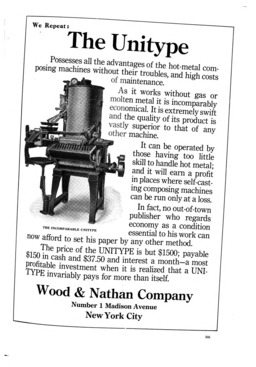
(From The Inland Printer, Vol. 45, No. 4 (July 1910): 505. Digitized by Google from the University of Michigan copy.)
Articles (both independent and otherwise), trade notes, and sections of some general histories.

Engineering (ca. 1887)
The 1887 Scientific American article (see below) says that it was drawn from material in the journal Engineering.
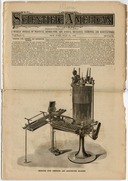
Scientific American (1887)
Scientific American. Vol. 57 [New Series], No. 4 (July 23, 1887): pp 47, 52. This is a secondhand account (derived from one in Engineering [particulars as yet unknown] which describes the Thorne as shown at an exhibition in London. It shows a keyboard layout which is alphabetic (rather than the layout adapted for simultaneous keying which is shown in [Thorne 1894]). It describes a machine more like the one of Thorne's 1880 patent than the one it actually illustrates on its p. 47.
I scanned this from my printed copy of this issue. The icon here links to a PDF presentation of a 600dpi RGB scan converted to JPEG images; it is 40 Megabytes in size (which is a bit large for two pages, but it's nice to have it at a reasonable resolution). Below is the primary image of the machine from the article. Clicking on it links to a 2048 pixel wide JPEG. Here is the full-resolution original scan (1200 dpi, 90 Megabytes): scientific-american-vol057-n04-1887-07-23-p052-image-thorne-1200rgb-crop-5840x10608.png

Science (1889)
"The Thorne Type-Setting Machine." Science. Vol. 13, No. 314 (Friday, February 8, 1889): 93-94.
This digitization has been released for noncommercial use by the JSTOR digital library. The icon at left links to the PDF version. Here is the DjVu version: science-1889-02-08-thorne-jstor-1762659.djvu The image of the Thorne from this article is reproduced as a JPEG image below. click on it for a full-resolution version.
Here is the original JPEG2000 format image for the digitization of this page: science-1889-02-08-thorne-jstor-1762659_0001.jp2 (Many image viewers and browsers cannot yet handle JPEG2000 images.)
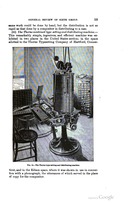
Paris Exhibition (1889)
Reports of the United States Commissioners to the Universal Exposition of 1889 at Paris . Vol. III, Sixth Group. (Washington, DC: Government Printing Office, 1891): 53-55.
Digitized by Google from the University of Michigan copy. The icon here links to an extract of just the pages relevant to the Thorne, as a PDF. The moire issue in the digitization of the halftone is present in Google's scan. Below is the cut of the Thorne, extracted from the Google PDF and rendered from JPEG2000 to PNG (click for the full-available-resolution image):
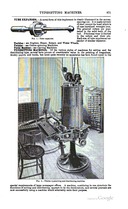
Modern Mechanism (1892)
Benjamin, Park, ed. Modern Mechanism. (NY: The Norman W. Henley Publishing Co., 1904) This extract is from the 1904 reprint, but the copyright date is 1892.
Digitized by Google from the University of Wisconsin copy. The icon at left links to an extract from this digitization of the two pages concerning the Thorne.

Popular Science Monthly
[I have an old note to myself indicating that this machine was discussed in Popular Science Monthly, using the same image as that in Modern Mechanism (see above). I've lost the exact citation, however. I have since, I hope, learned to take better notes.]
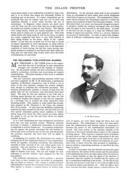
Inland Printer (Des Jardins Justifier; 1896)
Inland Printer. Vol. 17, No. 6 (Sept. 1896): 653-654.
Digitized by Google from the University of Minnesota copy. The icon here links to an extract of just the pages which contain the Des Jardins article.

British Printer (1898)
The British Printer. Vol. 11, No. 64 (July-August 1898): 180. A brief trade note reprinting information from Newspaperdom [citation presently unknown to me], this outlines the merger of the Cox company and the Thorne company into the Unitype company.
Digitized by Google from the University of Minnesota copy. The icon here links to an extract of just the pages which contain the note.
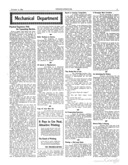
Newspaperdom (1899)
Anon. "Practical Experience With the Typesetting Machine." Newspaperdom, Vol. 8, Issue 9 (October 12, 1899): 3 [Note: The volume and issue number are from the Google metadata for this item. The item itself lacks its first page.]
This brief account is significant because it provides evidence that aluminum-alloy type was in fact sold. It is likely that this is type made under the patent of Thomas MacKellar (US patent 463,427, issued 1891-11-17), although the weight reduction claimed in the article is incommensurate with amount of aluminum specified in MacKellar's patent.
Note that although this article refers to the "Thorne," an ad in the same number of Newspaperdom promotes the "Simplex."
Digitized by Google. The icon here links to an extract of just p. 3, which contains the Thorne article.
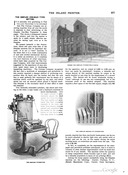
Inland Printer (1899)
"The Simplex One-Man Type-Setter." The Inland Printer, Vol. 23, No. 3 (June, 1899): 377-378.
Digitized by Google from the Harvard University copy. The icon here links to an extract of just the pages which contain the Simplex article.

American Printer & Bookmaker (1900)
Cochrane, Charles H. "Composing Machines of To-Day."The American Printer and Bookmaker. Vol. 29, No. 5 (Jan. 1900): 256-257. This article covers a number of machines of various technologies: the (old) Thorne, Empire, Linotype, McMillan, Cox, Simplex, Dow, Goodson, Johnson, and the newly introduced Monotype. It presents a type of business analysis of each, based primarily upon the labor cost of operators. It's also interesting because it links the Cox to Barnhart Brothers and Spindler (but stops short of saying that they owned the Cox firm).
Digitized by Google from the University of Michigan copy. The icon here links to an extract of just the pages which contain the Cochrane article.
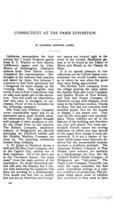
Connecticut Magazine (1900)
Daniel, Elizabeth Gertrude. "Connecticut at the Paris Exposition." The Connecticut Magazine. Vol. 6, No. 6 (September-October, 1900): 431-437. This is a report of the exhibits at the Connecticut section of the Exposition Universelle at Paris in 1900. It is interesting in that it mentions only briefly the firms which one today associates with Connecticut manufacture, such as Pratt and Whitney, Bullard, Bridgeport, and Stanley. Instead, it is concerned largely with the Des Jardins Type Justifier as (apparently) applied to a machine of the Unitype company. Apparently the Des Jardins Type Justifier Company won three diplomas, a gold medal, a silver medal, and an honorable mention. It appears at this point to be a separate concern from the Unitype company. It also displayed a type-writer adding machine (illustrated).
Digitized by Google. The icon here links to an extract of just the pages which contain the Daniel article.
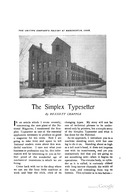
National Magazine (1902)
Chapple, Bennett. "The Simplex Typesetter." The National Magazine, Vol. 16, No. 6 (September 1902): 754-757. With a portrait of Herbert L. Baker, General Manager of the Unitype Company.
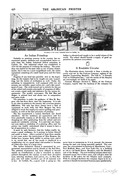
The American Printer (1903)
"A Readable Circular." The American Printer. Vol. 36, No. 5 (July, 1903): 456. This is a brieff account of the receipt by the magazine of a circular published by the Unitype Company ("makers of the Simplex Typesetting Machine"). This is interesting because, unless the editors of American Printer slipped and simply called the machine by a name familiar to them, it indicates that the "Simplex" name was in use at this date.
Digitized by Google from the University of Michigan copy. The icon at left links to an extract of this page from that digitization.

Thompson (1904, Thorne Extract)
Thompson, John S. History of Composing Machines. (Chicago: The Inland Printer Company, 1904.) The material in this book appeared originally in serial form in The Inland Printer. Thompson conducted the "Machine Composition" column for that journal and wrote the most popular technical work on the Linotype, The Mechanism of the Linotype. He later developed the Thompson Type-Casting Machine, which is still in use today. The icon here links to a PDF-format extract of the pages dealing with the Thorne and Simplex (at the time he wrote it the Unitype was in the future).
Here are the illustrations of the Thorne and Simplex from this book. (Click on each for a 1200dpi greyscale version.)
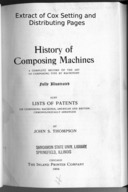
Thompson (1904, Cox Extract)
Thompson, John S. History of Composing Machines. (Chicago: The Inland Printer Company, 1904.) The icon here links to a PDF-format extract of the pages dealing with the various Cox machines, as well as his 1898 "multispace" spacing idea. (Note: p. 38 is absent from this PDF, but not "missing" - it contained an illustration of an unrelated machine.)
Here's the illustration from Thompson of Cox's first typesetting machine (click for a 1200dpi greyscale version):
Here's the illustration from Thompson of Cox's second typesetting machine (the one which used corrugated spaces for justification), along with the auxiliary machine to discard these corrugated spaces before the type was distributed and the (separate) distribution machine (click any image for a 1200dpi greyscale version of it):
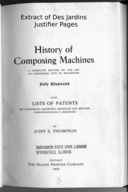
Thompson (1904, Des Jardins Extract)
Thompson, John S. History of Composing Machines. (Chicago: The Inland Printer Company, 1904.) The icon here links to a PDF-format extract of the pages dealing with the Des Jardins Justifier. Thompson is incorrect in the spelling "Des Jardines" [Des Jardins/Jardines].
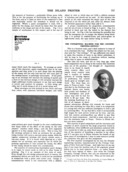
Inland Printer (August 1906; Ladd
Ladd, J. Linn. "The Typesetting Machine for the Country Printing-Office." The Inland Printer. Vol. 38, No. 1 (October 1906): 707, 709-710.
Digitized by Google from the University of Michigan copy and available via The Hathi Trust (Hathi ID: mdp.39015086781104). The icon here links to an extract of just this article.
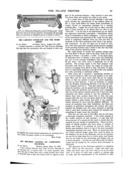
Inland Printer (October 1906; Chapple)
"Joe Mitchell Chapple on Composing Machines." The Inland Printer. Vol. 38, No. 1 (October 1906): 67-68. This is a reply to the earlier article by Ladd by a fond former Simplex user who now prefers his Monotype. It has little information on the Simplex, but is an interesting study in wages and opinions about machines.
Digitized by Google from the University of Michigan copy and available via The Hathi Trust (Hathi ID: mdp.39015086781294). The icon here links to an extract of just this article.

Lewis (ca. 1906)
Lewis, William. E. A Week's Instruction on the Simplex One-Man Typesetter. [publication details unknown; presumably 1906]
This book is noted and reviewed by John S. Thompson in the "Machine Composition" column of The Inland Printer, Vol. 38, No. 4 (July 1907), p. 573. He indicates that it was "Originally published serially in Newspaperdom" and that it cost $1.50, postpaid. Of it he says:
"A welcome addition to the literature on the art is the book just published by William E. Lewis, entitled "A Week's Instruction on the Simplex One-Man Typesetter." It is a complete book of instruction in both the operation and care of the Simplex machine, written in a style which makes it readily understandable. The work is freely illustrated and printed on one side only of the sheet, leaving facing pages blank for memoranda. It is a book of forty-two pages, 8 by 12 inches, and is listed at the head of this department."
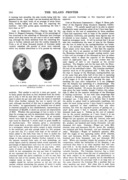
Inland Printer (May 1907)
Howe, Edgar F. "Cost of Machine Composition" [a letter reprinted in John S. Thompson's "Machine Composition" column in] The Inland Printer. Vol. 39, No. 2 (May 1907): 244-245. This is a comparison of the relative costs, on several bases, of the Simplex, the Linotype, and the Monotype.

Bullen (1907)
Bullen, Henry Lewis [writing as "Quadrat"] "Discursions of a Retired Printer" [occasional column], The Inland Printer, Vol. 39, No. 4 (July 1907): 513-519. With reference to the Thorne/Simplex, Bullen writes:
"In 1896 when the Thorne Typesetting Machine Company was at the height of its success the American Type Founders Company was in its worst estate. Several gentlemen who were alarmed at the prospect saw the necessity of a change of management, and induced Mr. Nelson to purchase an interest and become a director. The Thorne Typesetting Machine Company, which was one of the largest purchasers of type, formed an alliance with the American Type Founders Company and later on united wiht the Cox Typesetting Machine Company, in which members of the company of Barnhart Brothers & Spindler owned a controlling interest, under the title of The Unitype Company. Some changes were made in the machine, and it was renamed the Simplex." (518)
The link to BB&S, if true, would be quite interesting. In the absence of cross-checking, though, Bullen cannot be trusted.

Inland Printer (1910)
Wood & Nathan Co. "Mechanical Methods as Vital as Costs." [in "Business Notices" section] The Inland Printer, Vol. 44, No. 6 (March, 1910): 915-916.
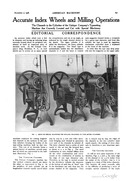
American Machinist (1908)
"Accurate Index Wheels and Milling Operations." American Machinist. Vol. 31 (November 5, 1908): 657-660. An interesting study of the manufacturing precision necessary to build the Unitype. By this time their factory had been relocated to Brooklyn.
I am indebted to Stephen O. Saxe for drawing my attention to this article.
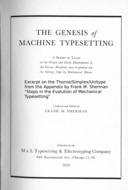
Sherman (1950)
Sherman, Frank M., ed. The Genesis of Machine Typesetting (Chicago: M & L Typesetting & Electrotyping Company, 1950)
This book provides three illustrations of the machine in different stages of its evolution and a very brief account of its history (in an Appendix, "Steps in the Evolution of Mechanical Typesetting," written by Sherman). The icon here links to an extract of just the Thorne/Simplex/Unitype materials from my scan of this book. It is 94 Megabytes in size, though, so it will take a while to download. (I have not yet uploaded it to The Internet Archive.)
You know your product has made it when other people start coming out with accessories for it. The Simplex almost made it.
An advertisement which ran in the October, 1906 (Vol. 38, No. 1) number of The Inland Printer (and in several subsequent issues in that volume) promoted "Facsimile Simplex Keyboards - Printed on heavy ledger paper. 15 cents." (p. 86) These would have been for keyboard practice. Similar printed practice keyboards (as well as non-functional but three-dimensional metal practice keyboards) were produced at various times for Linotype operators.
A 1906 Hamilton Manufacturing Company ad for galley shelving specifically mentions an option of "soft-wood shelving ... for drying Simplex type".
(From The Inland Printer, Vol. 37, No. 4 (July 1906): 485. Digitized by Google from the University of Minnesota copy.)
For a third-party instruction book on the Simplex, see William E. Lewis' A Week's Instruction on the Simplex .
Here are all of the patents by Joseph Thorne, or assigned to the Thorne company (or its successors), or otherwise relevant to the Thorne, that I could discover. It is almost certain that there are more that I didn't find (searching 19th century patents has its issues). [TO DO: check the patent list in Legros & Grant]
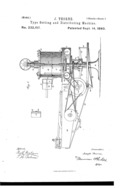
US Patent 232,157 (Thorne, 1880)
US patent 232,157, "Type Setting and Distributing Machine." Issued 1880-09-14 to Joseph Thorne. Filed 1880-03-30 (no application serial number given; there was a model).
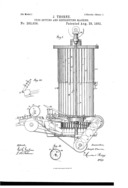
US Patent 283,934 (Thorne, 1883)
US patent 283,934, "Type Setting and Distributing Machine." Issued 1883-08-28 to Joseph Thorne. Filed 1882-11-10 (no application serial number given, no model.
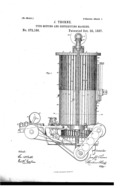
US Patent 372,186 (Thorne, 1887)
US patent 372,186, "Type Setting and Distributing Machine." Issued 1887-10-25 to Joseph Thorne. Filed 1885-06-04 as application serial number 167,599.
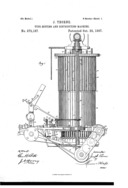
US Patent 372,186 (Thorne, 1887)
US patent 372,187, "Type Setting and Distributing Machine." Issued 1887-10-25 to Joseph Thorne. Filed 1887-02-17 as application serial number 231,218.

US Patent 387,546 (Thorne, 1888)
US patent 387,546, "Justifying Apparatus." Issued 1888-08-07 to Joseph Thorne. Filed 1885-06-04 as application serial number 167,600. Assigned to the Thorne Machine Company, of New York.
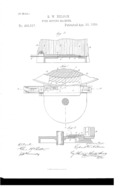
US Patent 402,537 (Nelson, 1889)
US patent 402,537, "Type-Setting Machine." Issued 1889-04-30 to Robert W. Nelson. Filed 1888-03-08 as application serial number 266,598. Assigned to the Thorne Machine Company, of Hartford, CT.
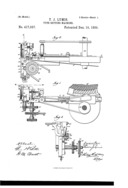
US Patent 417,057 (Lumis, 1889)
US patent 417,057, "Type-Setting Machine." Issued 1889-12-10 to Thomas J. Lumis. Filed 1888-02-10 as application serial number 263,619. Assigned to the Thorne Machine Company, of Hartford, CT.
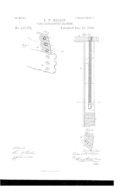
US Patent 417,074 (Nelson, 1889)
US patent 417,074, "Type-Distributing Machine." Issued 1889-12-10 to Robert W. Nelson. Filed 1889-03-30 as application serial number 305,379. Not assigned, but described as an improvement on the machines of Thorne's patents.
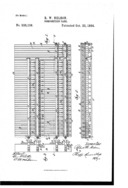
US Patent 528,106 (Nelson, 1894)
US patent 528,106, "Composition-Case." Issued 1894-10-23 to Robert W. Nelson. Filed 1894-03-13 as application serial number 503,407. Not assigned.
An "improved compositor's case especially intended for use as a correction case in justifying and correcting type set by machine".
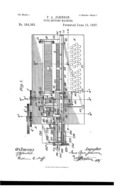
US Patent 584,362
US patent 584,362, "Type-Setting Machine." Issued 1897-06-15 to Frank Amos Johnson. Filed 1896-11-30 as application serial number 613,973. Assigned to the Johnson Typesetter Company, of Portland, Maine.
This is a machine technically unrelated to the Thorne (and presumably would have been a competitor to it). I've included it here only because Johnson later patented a type casting machine (US patent 867,277, 1907-10-01, but filed 1898-11-14) which was intended to supply types to type setting machines such as this one, and assigned that patent to the Unitype Company.

US Patent 631,062 (Cox, 1899)
US patent 631,062, "Multispace." Issued 1899-08-15 to Paul Flemming Cox. Assigned to the Unitype Company, of Manchester, CT. Filed 1898-09-14 as application serial number 690,693. A spacer for use in typesetting machines consisting of a collection of spaces of different thicknesses arranged in a line. In use, all but the space desired would be broken away.

US Patent 646,358 (Cox, 1900)
US patent 646,358, "Type-Setting Machine." Issued 1900-03-27 to Paul Flemming Cox. Filed 1899-08-14 as application serial number 727,095. Assigned to the Unitype Company, of Manchester, CT. Cox's improvements to the Thorne.
Cox also references his own prior patents, No. 528,856 (1894-11-06), No. 534,550 (1895-02-19), No. 581,954 (1897-05-04), and No. 601,498 (1898-03-29).
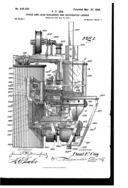
US Patent 646,359 (Cox, 1900)
US patent 646,359, "Space and Lead Discarder and Distributor-Loader." Issued 1900-03-27 to Paul Flemming Cox. Filed 1899-08-30 as application serial number 728,965. Assigned to the Unitype Company, of Manchester, CT.
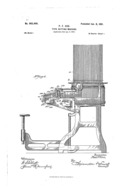
US Patent 665,406 (Cox, 1901)
US patent 665,406, issued 1901-01-08 to Paul Flemming Cox. Filed 1900-04-02 as application serial number 11,190. Assigned to the Unitype Company, of New York, NY.
This patent references Cox's patents 646,358 (application 727,095) and 646,359 (application 728,965), q.v.
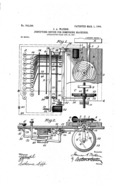
US Patent 753,336 (Watson, 1904)
US patent 753,336, "Justifying Device for Composing-Machines." Issued 1904-03-01 to James A. Watson. Filed 1897-08-24 as application serial no. 649,350. Assigned to the Unitype Company, of Manchester, CT.

US Patent 769,168 (Johnson, 1904)
US patent 769,168, "Machine for Manufacturing Justified-Line Matrices." Issued 1904-09-06 to Frank Amos Johnson. Filed 1899-10-24 as application serial number 734,645. Assigned to the Unitype Company.
This device would seem unrelated to the Thorne itself, but rather appears to be an improvement in matrix-making for Johnson's earlier "Impression Slug-Caster" (Huss' Catalog No. 137) of 1892. [Huss 1973]
This patent bears an amendment, dated 1904-10-18, which is a useful date indicator in Unitype corporate history. It amends the patent assignment from "The Unitype Company, of Manchester, Connecticut, a Corporation of Connecticut" to "The Unitype Company, of Manchester, Connecticut, a Corporation of New Jersey."
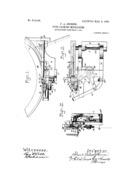
US Patent 814,048 (Johnson, 1906)
US patent 814,048, "Type-Packing Mechanism." Issued 1906-03-06 to Frank Amos Johnson. Filed 1904-05-06 as application serial number 208,630. Assigned to the Unitype Company, of Manchester, CT, a corporation of New Jersey.
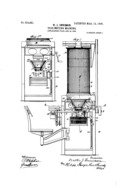
US Patent 814,681 (Johnson, 1906)
US patent 814,681, "Type-Setting Machine." Issued 1906-03-13 to Walter J. Ennisson. Filed 1902-04-18 as application serial number 103,491. Assigned to the Unitype Company, of Manchester, CT, a corporation of New Jersey.
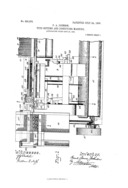
US Patent 826,578 (Johnson, 1906)
US patent 826,578, "Type Setting and Justifying Machine." Issued 1906-07-24 to Frank Amos Johnson. Filed 1899-09-23 as application serial number 731,479. Assigned to the Unitype Company, of Manchester, CT, a corporation of New Jersey.
It describes a machine "somewhat similar in its general outline to the machine shown in Letters Patent No. 607,047, issued [to Johnson] July 12, 1898." (607,047 was assigned to the Johnson Typesetter Company)
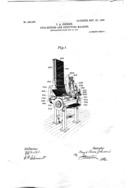
US Patent 836,687 (Johnson, 1906)
US patent 836,687 "Type Setting and Justifying Machine." Issued 1906-11-27 to Frank Amos Johnson. Filed 1901-10-19 as application serial number 79,236. Assigned to the Unitype Company, of Manchester, CT, a corporation of New Jersey.
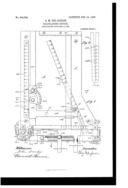
US Patent 844,554 (Des Jardins, 1907)
US patent 544,554, "Calculating Device." Issued 1907-02-19 to Benjamin M. Des Jardins. Filed 1895-05-17 as application serial number 549,729. Assigned to the Unitype Company, of Manchester, CT, a corporation of New Jersey.
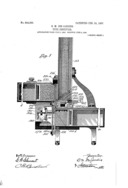
US Patent 844,555 (Des Jardins, 1907)
US patent 544,555, "Type-Justifier." Filed 1895-06-01, filing renewed 1906-06-05. Application serial number 320,226. Assigned to the Unitype Company, a corporation of New Jersey.
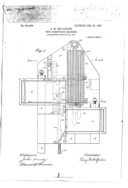
US Patent 844,556 (Des Jardins, 1907)
US patent 844,556, "Type-Justifying Machine." Issued 1907-02-19 to Benjamin M. Des Jardins. Filed 1895-05-20 as application serial number 550,015. Assigned to the Unitype Company, a corporation of New Jersey.

US Patent 844,557 (Des Jardins, 1907)
US patent 844,557, "Type-Justifying Machine." Issued 1907-02-19 to Benjamin M. Des Jardins. Filed 1895-05-20 as application serial number 550,016. Assigned to the Unitype Company, a corporation of New Jersey.
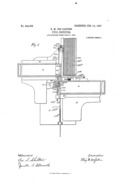
US Patent 844,558 (Des Jardins, 1907)
US patent 844,558, "Type-Justifier." Issued 1907-02-19 to Benjamin M. Des Jardins. Filed 1895-07-11 as application serial number 555,669. Assigned to the Unitype Company, a corporation of New Jersey.
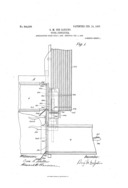
US Patent 844,559 (Des Jardins, 1907)
US patent 844,559, "Type-Justifier." Issued 1907-02-19 to Benjamin M. Des Jardins. Filed 1895-07-01 as application serial number 299,508. Assigned to the Unitype Company, a corporation of New Jersey.
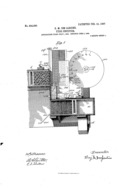
US Patent 844,560 (Des Jardins, 1907)
US patent 844,560, "Type-Justifier." Issued 1907-02-19 to Benjamin M. Des Jardins. Filed 1895-07-01 as application serial number 320,227. Assigned to the Unitype Company, a corporation of New Jersey.
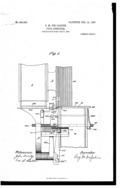
US Patent 844,561 (Des Jardins, 1907)
US patent 844,561, "Type-Justifier." Issued 1907-02-19 to Benjamin M. Des Jardins. Filed 1895-07-01 as application serial number 320,227. Assigned to the Unitype Company, a corporation of New Jersey.
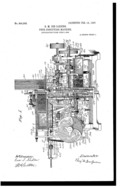
US Patent 844,562 (Des Jardins, 1907)
US patent 844,562, "Type-Justifying Machine." Issued 1907-02-19 to Benjamin M. Des Jardins. Filed 1898-06-02 as application serial number 682,855 1/2. Assigned to the Unitype Company, a corporation of New Jersey.
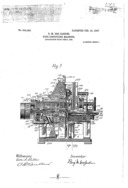
US Patent 844,563 (Des Jardins, 1907)
US patent 844,563, "Type-Justifying Machine." Issued 1907-02-19 to Benjamin M. Des Jardins. Filed 1898-06-04 as application serial number 682,856. Assigned to the Unitype Company, a corporation of New Jersey.
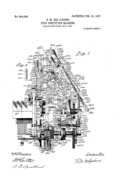
US Patent 844,564 (Des Jardins, 1907)
US patent 844,564, "Type-Justifying Machine." Issued 1907-02-19 to Benjamin M. Des Jardins. Filed 1898-08-03 as application serial number 687,620. Assigned to the Unitype Company, a corporation of New Jersey.
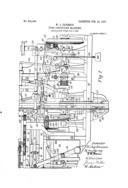
US Patent 844,565 (Ennisson, 1907)
US patent 844,565, "Type-Justifying Machine." Issued 1907-02-19 to Walter Jay Ennisson. Filed 1898-08-03 as application serial number 687,639. Assigned to the Thorne Type Setting Machine Company, a corporation of New Jersey.
This patent cites the earlier patent of Ennisson and William H. Honiss, No. 583,224 of 1897-05-25. Honiss signed as a witness on the present patent.

US Patent 844,566 (Ennisson, 1907)
US patent 844,566, "Type-Justifying Machine." Issued 1907-02-19 to Walter Jay Ennisson. Filed 1899-06-14 as application serial number 720,450. Assigned to the Thorne Type Setting Machine Company, a corporation of New Jersey.
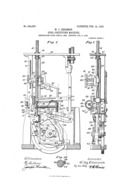
US Patent 844,567 (Ennisson, 1907)
US patent 844,567, "Type-Justifying Machine." Issued 1907-02-19 to Walter Jay Ennisson. Filed 1899-06-14. Filing renewed 1906-08-11. Application serial number 330,147. Assigned to the Thorne Type Setting Machine Company, a corporation of New Jersey.
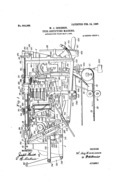
US Patent 844,568 (Ennisson, 1907)
US patent 844,568, "Type-Justifying Machine." Issued 1907-02-19 to Walter Jay Ennisson. Filed 1902-05-05 as application serial number 106,010. Assigned to the Unitype Company, a corporation of New Jersey.
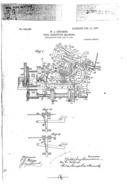
US Patent 844,569 (Ennisson, 1907)
US patent 844,569, "Type-Justifying Machine." Issued 1907-02-19 to Walter Jay Ennisson. Filed 1904-08-23 as application serial number 221,814. Assigned to the Unitype Company, a corporation of New Jersey.
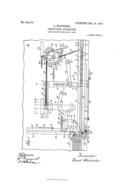
US Patent 844,570 (Wentscher, 1907)
US patent 844,570, "Justifying Apparatus." Issued 1907-02-19 to Ernst Wentscher, a subject of the German Emperor, residing in Berlin, Germany. Filed 1895-08-06 as application serial number 558,429. Assigned to the Unitype Company, a corporation of New Jersey.
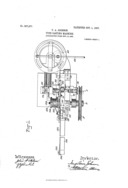
US Patent 867,277 (Johnson, 1907)
US patent 867,277, "Type-Casting Machine." Issued 1907-10-01 to Frank Amos Johnson. Filed 1898-11-14 as application serial number 696,419. Assigned to the Unitype Company, of Manchester, CT, a corporation of New Jersey.
"The object of the present invention is to provide a type casting machine for newspaper and book composing rooms adapted to cast the various types required to supply the type setting machine." It references Johnson's patent 584,362 (1897-06-15).
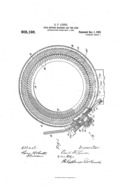
US Patent 905,196 (Linke, 1908)
US patent 905,196, "Type-Setting Machine and the Like." Issued 1907-12-01 to Emil F. Linke. Filed 1906-05-01 as application serial number 314,675. Assigned to the Unitype Company, of New York, NY, a corporation of New Jersey.

US Patent 935,968 (Des Jardins, 1909)
US patent 935,968, "Type Setting and Justifying Machine." Issued 1909-10-05 to Benjamin M. Des Jardins. Filed 1902-12-13 as application serial number 135,114. Assigned to the Unitype Company, of Manchester, CT, a corporation of New Jersey.
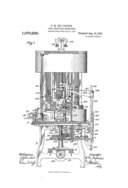
US Patent 1,070,235 (Des Jardins, 1913)
US patent 1,070,235, "Type-Justifying Mechanism." Issued 1913-08-12 to Benjamin M. Des Jardins. Filed 1899-05-15 as application serial number 716,915.
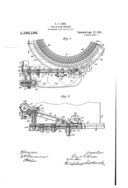
US Patent 1,150,134 (Linke, 1915)
US patent 1,150,134, "Type-Setting Machine." Issued 1915-08-17 to Emil F. Linke. Filed 1913-07-10 as application serial number 778,306. Assigned to the Unitype Company, a corporation of New Jersey.
A machine survives in the collection of the International Printing Museum in California. Their information on it indicates that it is 62 inches high (for comparison, a later Blue-Streak era single-magazine Model 5 Linotype is 79 inches high). For an account of the acquisition of this machine in 1955 by Ernie Lindner (whose collection became the IPM), see [IPM 1994]. For another photograph of it, see: http://www.printingmuseum.org/museum/collection/
A machine, identified as a Unitype, survives in the collection of the the Museum of Printing in North Andover, Massachusetts. See: http://museumofprinting.org/Collection.html This machine is also illustrated in the September 2007 issue of the "News" from the Museum of Printing. This is a special edition entitled "Treasures of the Museum," and the reference is in an article on the Linotype, "When Clephane met Mergenthaler." It does contain the interesting claim that four Thorne/Simplex/Unitype machines survive. See: http://museumofprinting.org/Collection.html
In the early 1920s, a Unitype machine was given by American Type Founders to the Smithsonian Institution. See the Report of the Secretary of the Smithsonian Institution for the Year Ending June 30, 1922 . [Publication 2709] (Washington, DC: U.S.Government Printing Office, 1922): 36.
(But excluding references reprinted above in the Company Literature and Third Party Literature sections, unless they are also referenced in the text.)
[BP 1898] Anon. [trade note in] The British Printer. Vol. 11, No. 64 (July-August 1898): 180.
[IPM 1994] Anon. "Joseph Thorne and the Typesetting Race." The Wayzgoose Gazette, Vol. 4, Nos. 2 and 3 (Summer and Fall, 1994): 1-3.
A quarterly newsletter of the International Printing Museum. This issue is online on their website at: http://www.printmuseum.org/docs/Wayzgoose/1994(v4n2&n3)-Summer.pdf.)
Anon. "Improved Type Composing and Distributing Machine." Scientific American. Vol. 57 [New Series], No. 4 (July 23, 1887): pp 47, 52.
[Bullen 1924] Bullen, Henry Lewis. "The Transition from Hand-Set to Machine-Set Composition." The Inland Printer, Vol. 72, No. 4 (January, 1924)
This is the first in a series of six articles by Bullen. I am only presuming that it covers the Thorne; I have not yet read it.
There has been some confusion over the spelling of the surname of Benjamin M. Des Jardins. It is recorded as "Des Jardins" in his various patents, in which presumably he would have taken some care to ensure its correct spelling. Huss also uses Des Jardins [Huss 1973]. Thompson and some other sources, however, have used "Des Jardines." This would appear to be an error.
[Eckman 1965] Eckman, James. The Heritage of the Printer, Vol. 1. Philadelphia: North American Publishing Company, 1965.
Eckman gives a brief account of the Simplex / Unitype in his chapter "The Linotype Beat the Unitype, All 'Round the Town." It contains several historical details not present in [Huss 1973]. However, Eckman does not cite his sources for this popular account. Elsewhere in this book, he has been mislead by Bullen's fanciful stories (for example, he repeats Bullen's demonstrably false account of the evolution of Benton's pantograph engraving machines (p. 111.)) So until it can be verified that his sources are not Bullen's works, it is best to treat this account with caution. He attributes the demise of the Unitype to the pressure in the market of the Linotype Junior - an interesting position given the commercial failure of that machine.
[Hattersley] For longevity as a typesetter in the marketplace, the Thorne/Simplex/Unitype was eclipsed by the Hattersley ( [Huss 1973] Catalog No. 31, from 1857 to the early 20th century). The McMillan typesetter (Huss Catalog No. 92) came close (1883 to the 1890s).
[Huss 1973] Huss, Richard E. The Development of Printers' Mechanical Typesetting Methods: 1822-1925. Charlotte, VA: By the University Press of Virginia for the Bibliographical Society of the University of Virginia, 1973.
[IP 1896 DJ] "The Des Jardins Type-Justifying Machine." Inland Printer (Sept. 1896): 653-654.
Digitized by Google and available via the Hathi Trust. For a local reprint, see the reference to it above.
[Simplex 1901] "The Simplex One-Man Typesetter." (NY: The Unitype Company, 1901) [undated, but datable to 1901 through its references to the Pan-American Exposition]
This advertising brochure has been scanned by Stephen O. Saxe and is available online. See the reference to it above.
[Simplex Owner] [An "owner's booklet" for the Simplex] ([unknown]: The Unitype Company, [unknown])
A Simplex One-Man Typesetter "owner's booklet" by the Unitype Company is referenced in [Huss 1973], p. 195. His illustration of the Simplex, which is different from that shown in the [Simplex 1901], is from this booklet.
[Sing Sing & Ossining] Probably the Village of Ossining.
The village now known as Ossining was known as Sing Sing until 1901 (when it changed its name to avoid conflation with the federal prison of Sing Sing).
[Spalding 1891] Spalding, J. A. Illustrated Popular Biography of Connecticut. Hartford, CT: Press of the Case, Lockwood & Brainard Company, 1891.
A reprint of the section on Robert W. Nelson appears in the CircuitousRoot Notebook on Nelson
There are several entries in [Huss 1973] for Frank Amos Johnson; he would seem to have been a relatively prolific inventor. Huss indicates that he applied the name "tachytype" to several quite different machines. These Johnson Tachytype machines should not be confused with the 1849 "Tachéotype" of Christian Sörenson in Denmark (Huss' Catalog No. 13), which was the first machine to embody the superimposed cylinder method of the Thorne. ("Tachys" is Greek for "rapid.")
[Thompson 1904] Thompson, John S. A History of Composing Machines.
This material first appeared as a series of articles in The Inland Printer. This is the same John S. Thompson who wrote what was at the time the best-selling book on the Linotype ( Mechanism of the Linotype) and developed the Thompson Type-Caster.
An extract of the material on the Thorne is reprinted above.
[Thorne 1894] Thorne Type-Setting Machine Co. "The Thorne Type-Setting Machine." Hartford, CT: The Thorne Type-Setting Machine Company, 1894.
This advertising brochure has been scanned by Stephen O. Saxe and is available online. See the reference to it above.
[Unitype WN] "The Unitype One-Man Type Setting Machine." (NY: Wood & Nathan Co.) This brochure is undated, but as it refers to the "Unitype" as an improvement over the "Simplex" it must postdate the "Simplex One-Man Type Setter" brochure of 1901 (see above) Wood & Nathan Co. were advertising the Unitype in The Inland Printer as late as 1910.
This advertising brochure has been scanned by Stephen O. Saxe and is available online. See the reference to it above.
[Unitype WN 2] Wood & Nathan Co. "Mechanical Methods as Vital as Costs." [in "Business Notices" section] The Inland Printer, Vol. 44, No. 6 (March, 1910): 915-916.
Digitized by Google from the University of Minnesota copy and available via The Hathi Trust. Reprinted above.
At the time of writing (2013), online technology still isn't up to the lossless presentation of high-resolution digital imagery. The versions of the scans by Stephen O. Saxe and David M. MacMillan presented above and at The Internet Archive are, therefore, processed to reduce their size. Here, in the interests of archival completeness, are the original scans.
DMM's scans of "Improved Type Composing and Distributing Machine." Scientific American. Vol. 57 [New Series], No. 4 (July 23, 1887): pp 47, 52. :
Stephen O. Saxe's scans of "The Thorne Type-Setting Machine." (Hartford, CT: The Thorne Type-Setting Machine Company, 1894) :
Stephen O. Saxe's scans of "The Simplex One-Man Typesetter." (NY: The Unitype Company, 1901) :
Stephen O. Saxe's scans of "The Unitype One-Man Type Setting Machine" (NY: The Unitype Company, [n.d.; after 1901]) :
The 1887 issue of Scientific American is in the public domain, as is my scan of it here.
The original documents on the Thorne, Simplex and Unitype scanned by Stephen O. Saxe are in the public domain. He has placed his scans of them in the public domain. The extracts and original scans from them reprinted here remain in the public domain.
Sherman's The Genesis of Machine Typesetting is in the public domain due to the expiration of all possible copyright. The excerpts from it reprinted here remain in the public domain.
While the original of the 1889 Science article reproduced here from the JSTOR digitization is in the public domain, the JSTOR digitization is controlled by that entity. They have licensed it for noncommercial use, and it is used here under those terms. Please note that these license terms are not compatible with the Creative Commons Attribution-ShareAlike license used for this page as a whole, and that this JSTOR digitization is not licensed here under those terms.
The various digitizations by Google released for full viewing by the or the Hathi Trust which are reprinted here are in the public domain. As reprinted or excerpted here, they remain in the public domain.
All portions of this document not noted otherwise are Copyright © 2013 by David M. MacMillan and Rollande Krandall.
Circuitous Root is a Registered Trademark of David M. MacMillan and Rollande Krandall.
This work is licensed under the Creative Commons "Attribution - ShareAlike" license. See http://creativecommons.org/licenses/by-sa/3.0/ for its terms.
Presented originally by Circuitous Root®
Select Resolution: 0 [other resolutions temporarily disabled due to lack of disk space]